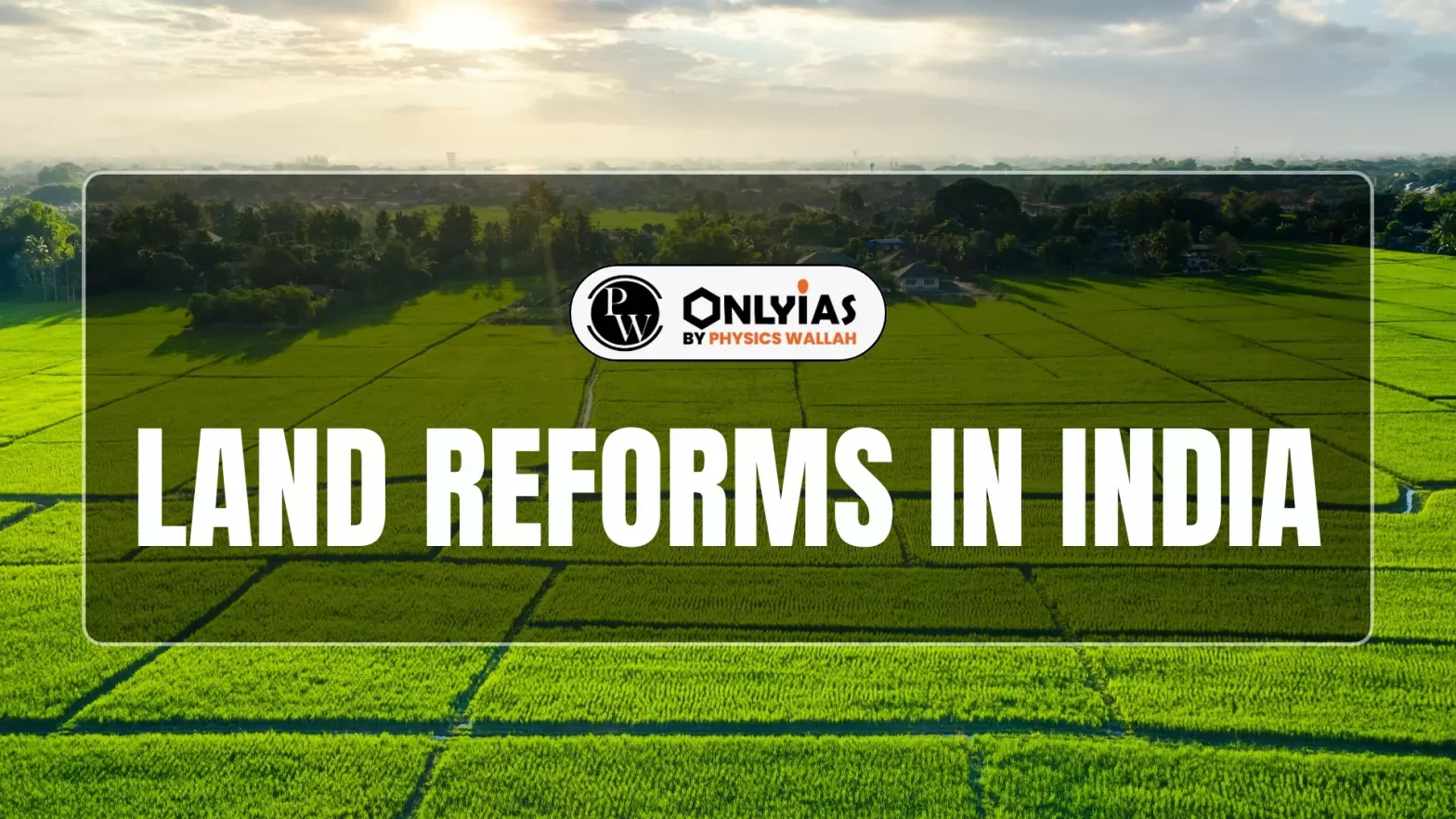Land reforms are crucial for economic development, social equity, and financial inclusion.
| Relevancy for Prelims: JAM trinity, Digital India Land Records Modernization Programme, Unique Land Parcel Identification Number, SVAMITVA Scheme, Model Agriculture Land Leasing Act, 2016, Gram Panchayat Development Plans (GPDP), etc.
Relevancy for Mains: Impact of land reforms on socio-economic conditions of marginal and small farmers, etc. |
Land Reforms in India: Background and Importance
- Clean land records are often overlooked in discussions of financial inclusion.
- Secure land tenure is a prerequisite for economic stability and growth.
- Clear land titles significantly enhance access to credit, especially in rural India.
Enroll now for UPSC Online Course
Current Challenges on Land Reforms in India
- Outdated, incomplete, or inaccurate land records.
- Small and fragmented land holdings.
- High number of land-related disputes.
- Inefficient land acquisition processes.
- Persistence of informal, unsecured borrowing despite JAM trinity advancements.
- Disproportionate impact on marginalized communities, especially women.
- Land scarcity: India’s land per capita projected to decrease significantly by 2050.
Key Government Initiatives on Land Reforms in India
a) Digital India Land Records Modernization Programme (DILRMP):
- Evolved from National Land Records Modernization Programme (NILRMP).
- Aim: Modernize land records management, minimize disputes, enhance transparency.
- Central Sector Scheme with 100% central government funding.
- Budget: ₹875 crores, extended from 2021-22 to 2025-26.
- New components: Computerization of revenue courts, Aadhaar integration with ROR.
- Progress:
-
- 95.09% of villages have computerized Records of Rights (RoRs).
- 68.02% of cadastral maps digitized.
- 94.95% computerization of registration completed.
- 87.48% integration of Sub Registrar offices with land records.
b) Unique Land Parcel Identification Number (ULPIN) or Bhu-Aadhar:
- 14-digit alphanumeric ID for each land parcel based on geo-coordinates.
- Complies with international standards (ECCMA and OGC).
- Includes ownership details, plot size, and geographical coordinates.
- Aims to facilitate real estate transactions and improve disaster planning.
c) SVAMITVA Scheme:
- Uses drone technology for precise land mapping in rural areas.
- Provides legal ownership cards to villagers.
- Supports property tax determination and Gram Panchayat revenue.
- Progress:
-
- 3,04,862 villages surveyed by drones.
- 9,29,91,300 parcels digitized.
- 2,53,805 maps handed over to state authorities.
- 1,21,593 property cards prepared, 72,712 distributed.
d) Model Agriculture Land Leasing Act, 2016:
- Aimed to improve land access for small and marginal farmers through leasing.
- Provides mechanism for tenants to avail institutional credit.
- Specifies rights and responsibilities of landowners and tenants.
- Includes dispute resolution mechanisms.
Check Out UPSC NCERT Textbooks From PW Store
Land Reforms in India: Political and Implementation Challenges
- Amendments to land acquisition law put in abeyance in 2015 due to political opposition.
- Withdrawal of three farm laws in 2021, including contract farming legalization.
- Slow implementation of Model Agriculture Land Leasing Act by states.
- Varying progress across states in ULPIN and SVAMITVA implementation.
- Lack of implementation in some states (e.g., West Bengal, Bihar for SVAMITVA).
Economic Impact
- GDP loss of about 1.3% due to land dispute-related project delays.
- 66% of civil suits in India related to land/property disputes.
- Average pendency of land acquisition disputes: 20 years.
- Major cause of cost escalation and time overruns in projects.
- Underemployment in agriculture sector (44% of workforce) partly due to fragmented holdings.
International Comparison and Future Projections
- India’s projected land per capita by 2050: 1/4th of current value.
- Significantly lower than China (4 times) and Brazil (20 times).
- Need for improved land record system due to land scarcity.
Proposed Reforms and Future Focus
- Shift from presumptive to conclusive land titling system.
- Complete implementation of DILRMP and ULPIN across all states.
- Focus on reducing disputes and delays in land acquisition.
- Potential changes in land-use policies for urban, forest, and agricultural land.
- Need for real-time updates of land records with encumbrance information.
- Integration of land records with satellite imagery.
- Addressing regional disparities in digitization and reforms implementation.
Benefits of Comprehensive Land Reforms
- Enhanced credit flow to needy sectors.
- Resolution of land-related disputes.
- Improved agricultural productivity through mechanization and scale.
- Greater financial flexibility for landowners.
- Improved supply chain efficiencies.
- Better disaster planning and response.
- Support for Gram Panchayat Development Plans (GPDP)
Enroll now for UPSC Online Classes
Conclusion
Comprehensive land reforms in India are imperative for economic growth, equity, and resilience, requiring streamlined implementation and inclusive policies to achieve sustainable development goals effectively.
![]() 19 Jul 2024
19 Jul 2024

